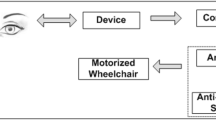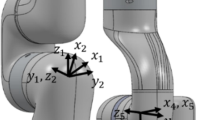Abstract
Purpose
Driving a power wheelchair (PW) can be challenging for individuals with severe motor disabilities who are unable to use a joystick for control. An alternative approach involves utilizing eye movement commands through electroculography techniques, which rely on image processing. However, this signal can be susceptible to noise interference. To address this issue, video-oculography (VOG) techniques offer a promising solution. In this study, we propose the development of a VOG-based system that utilizes the webcam of a laptop to facilitate PW driving. Our hypothesis is that such a VOG system can effectively and conveniently enable PW users to drive without the need for an additional eye-tracking device.
Methods
The system was specifically designed to enable users to interact with a laptop through webcam-based eye movement. To minimize costs, the entire system was developed using freeware tools. The software displays arrows on the laptop screen, indicating the direction the user should focus on in order to control the power wheelchair (PW). In order to assess the system's performance and usability, tests were conducted involving 10 participants, including both healthy individuals and those with disabilities. The system recorded the total number of commands issued and the corresponding PW movement directions for subsequent analysis. Statistical analysis and usability questionnaires were utilized to quantify and evaluate the level of difficulty associated with using our system.
Results
All participants exhibited proficiency in operating the power wheelchair (PW) without encountering any challenges. Furthermore, as per the participants' feedback, the implemented system holds promising potential to bestow PW users with enhanced autonomy, enabling them to independently navigate and thereby minimizing their reliance on external assistance to carry out daily activities.
Conclusion
The findings indicate that the proposed system holds utility for individuals with severe motor disabilities, offering potential benefits in their daily activities. However, in order to obtain a more precise statistical analysis of the power wheelchair (PW) user's performance, it is necessary to conduct testing with a larger participant pool. Additional studies with an increased sample size are warranted to further evaluate the effectiveness and performance of the proposed system.



Similar content being viewed by others
Availability of data and materials
The dataset supporting the conclusions of this article is included in the article.
References
L. Nilsson. 2002. Driving to Learn The role of powered wheelchair training in rehabilitation, 1st ed. The Swedish Handicap Institute,
Torkia C, et al. Power wheelchair driving challenges in the community: a users. Disabil Rehabil Assist Technol. 2015;10(3):211–5. https://doi.org/10.3109/17483107.2014.898159.
Cooper RA, et al. Driving characteristics of electric-powered wheelchair users: how far, fast and often do people drive? Arch Phys Med Rehabil. 2002;83:250–5.
S. Arlati, V. Colombo, G. Ferrigno, R. Sacchetti, and M. Sacco. Virtual reality-based wheelchair simulators: a scoping review. Assist Technol.
Arlati S, Colombo V, Ferrigno G, Sacchetti R, Sacco M. Virtual electric wheelchair controlled by electromyographic signals. Assistive Technol. 2013. https://doi.org/10.1080/10400435.2018.1553079.
C. Ishii and R. Konish. A control of electric wheelchair using and EMG based on degree of muscular activity in Euromicro conference on digital system design. 2016, pp. 5766–5769.
Carlson Tom, del Jose R. Brain-controlled wheelchairs mag. IEEE Robot Autom. 2013. https://doi.org/10.1109/MRA.2012.2229936.
Diez P. Smart wheelchairs and brain-computer interfaces. Cambridge: Academic Press; 2018.
Škrabaa A, Stojanovi R, Zupanc A, Koložvari A, Kofjac D. Speech-controlled cloud-based wheelchair platform for disabled persons. Microprocess Microsyst. 2015. https://doi.org/10.1016/j.micpro.2015.10.004.
Pajkanovic A, Dokic B. Wheelchair control by head motion. Serbian J Electr Eng. 2013;10(1):135–51.
Gomes D, Fernandes F, Castro E. Head-movement interface for wheelchair driving based on inertial sensors. IEEE 6th Portuguese Bioeng (ENBENG). 2019. https://doi.org/10.1109/ENBENG.2019.8692475.
Chacko JK, Oommen D, Mathew KK, Sunny N, Babu N. Microcontroller based EOG guided wheelchair. Int J Medical Heal Pharm Biomed Eng. 2014;7(11):482–5.
Champaty B, Jose J, Pal K, Thirugnanam A. Development of EOG based human machine interface control system for motorized wheelchair magnetics machines and drive. Ann Int Emerg Res Areas. 2014. https://doi.org/10.1109/AICERA.2014.6908256.
Pinheiro CG, Naves ELM, Pino P, Losson E, Andrade AO, Bourhis G. Alternative communication systems for people with severe motor disabilities: a survey. Biomed Eng Online. 2011;10:28. https://doi.org/10.1186/1475-925X-10-31.
Subash K. Design of EOG based human machine interface system. Int J Eng Res Gen Sci. 2016;4(4):20931.
Marjaninejad A, Daneshvar S. A low-cost real-time wheelchair navigation system using electrooculography. Iran Conf Electr Eng (ICEE). 2014. https://doi.org/10.1109/IranianCEE.2014.6999863.
Hermens HJ, Freriks B, Disselhorst-Klug C, Rau G. Development of recommendations for SEMG sensors and sensor placement procedures. J Electromyogr Kinesiol. 2000;10(5):361–74. https://doi.org/10.1016/S1050-6411(00)00027-4.
Borges LR, Martins FR, Naves EL. Electric-powered wheelchair control using eye tracking techiniques. Int J Innov Res Comput Commun Eng. 2016;4(9):16690–5. https://doi.org/10.15680/IJIRCCE.20160409121.
Naruniec J, Wieczorek M, SzlufikStanislaw S. Webcam-based system for video-oculography. IET Comput Vis. 2017;11(2):173–80. https://doi.org/10.1049/iet-cvi.2016.0226.
Cristanti RY, Sigit R, Harsono T, Adelina DC, Nabilah A, Anggraeni NP. Eye gaze tracking to operate android-based communication helper application. Proc Int Electron Symp Knowl Creat Intell Comput. 2017. https://doi.org/10.1109/KCIC.2017.8228569.
P. C. Levy, N. S. Antonio, T. R. B. Souza, R. Caetano, and P. G. Souza. ActiveIris: uma solução para comunicação alternativa e autonomia de pessoas com deficiência motora severa in Proc. 12th Brazilian Symp. Hum. Factors Comput. Syst. 2013, pp. 42–51.
SM_Brasil. Seat Mobile do Brasil,” 2018. http://www.seatmobile.com.br/sm2.asp (Accessed 09 Oct. 2018
Chen Y, et al. A real time multimodal biofeedback system for stroke patient rehabilitation. Proc ACM Int Multimedia. 2006. https://doi.org/10.1145/1180639.1180745.
H. T. Alvestrand. Overview: Real-Time Protocols for Browser-Based Applications no. 8825. RFC Editor. 2021. https://doi.org/10.17487/RFC8825
Chinthammit W, et al. Ghostman: augmented reality application for telerehabilitation and remote instruction of a novel motor skill. Biomed Res Int. 2014;2014: 646347. https://doi.org/10.1155/2014/646347.
Pycharm, “Pycharm - IDE Python,” 2021. https://www.jetbrains.com/pt-br/pycharm/ (Accesse 01 Aug. 2021).
Python, “Python Language,” 2021. https://www.python.org/ (Accessed 01 Aug 2021).
Kivy. Kivy - Open source Python library. 2021. https://kivy.org/#home (Accessed 01 Aug 2021).
Gaze_Tracking. Gaze Tracking 2021. https://github.com/antoinelame/GazeTracking. (Accessed 01 Aug 2021).
A. Ross. Basic and Advanced Statistical Tests. 2017.
Silva YMLR, Simoes WCSS, Naves ELM, Filho TFB, Lucena VFD. Teleoperation training environment for new users of electric powered wheelchairs based on multiple driving methods. IEEE Access. 2018;6:55099.
Meena YK, Cecotti H, Wong-Lin K, Prasad G. A multimodal interface to resolve the midas-touch problem in gaze controlled wheelchair. Annu Int Conf IEEE Eng Med Biol Soc EMBS. 2017. https://doi.org/10.1109/EMBC.2017.8036971.
Wästlund E, Sponseller K, Pettersson O, Bared A. Evaluating gaze-driven power wheelchair with navigation support for persons with disabilities. J Rehabil Res Dev. 2015;52:815–26. https://doi.org/10.1682/JRRD.2014.10.0228.
Mani N, Sebastian A, Paul AM, Chacko A, Raghunath A. Eye controlled electric wheel chair. Int J Adv Res Electr Electron Instrum Eng. 2015;4(10):15662.
Chee FP, Duinong M, Chang HWJ, Awang A, Francis AS, Dayou J. Eye tracking electronic wheelchair for physically challenged person. ARPN J Eng Appl Sci. 2017;12(13):4078–83.
Eid MA, Giakoumidis N, El Saddik A. A novel eye-gaze-controlled wheelchair system for navigating unknown environments: case study with a person with ALS. IEEE Access. 2016. https://doi.org/10.1109/ACCESS.2016.2520093.
Rodrigues C. Eye directive wheelchair. Int J Curr Eng Technol. 2015;5(4):2304–7.
Gautam G, Sumanth G, Karthikeyan KC, Sundar S, Venkataraman D. Eye movement based electronic wheel chair for physically challenged persons. Int J Sci Technol Res. 2014;3(2):206–12.
Cruz R, Souza V, Filho TB, Lucena V. Electric powered wheelchair command by information fusion from eye tracking and BCI. IEEE Int Conf Consum Electron ICCE. 2019;2019:1–2. https://doi.org/10.1109/ICCE.2019.8662090.
Dawson DR. Power-mobility indoor driving assessment manual (PIDA). Toronto-Canadá: Sunnybrook and Wonmen’s College Health Sciences Centre; 2006.
Kamaraj DC, Dicianno BE, Mahajan HP, Buhari AM, Cooper RA. Inter-rater reliability of the power mobility road test in the virtual reality based simulator-2. Arch Phys Med Rehabil. 2016. https://doi.org/10.1016/j.apmr.2016.02.005.
Funding
This study was financed in part by the Coordenação de Aperfeiçoamento de Pessoal de Nível Superior – Brasil (CAPES). Finance Code 001.
Author information
Authors and Affiliations
Contributions
EMS supervised the experiments and wrote the first draft of the manuscript. ELMN and ACP supervised, revised, and gave the final approval of the manuscript. AARS has been involved in drafting the manuscript and revising it critically for important intellectual content and final approval of the published version. All authors read and approved the final manuscript.
Corresponding author
Ethics declarations
Conflict of interest
The authors declare that they have no conflict of interest.
Ethical approval
Approved by the Ethics Committee from the Federal University of Uberlandia – Brazil. Prot. Number: 86694117.4.0000.5152.
Consent to participate
Informed Consent Document was signed by participants and approved by the Ethics Committee from the Federal University of Uberlandia – Brazil. Prot. Number: 86694117.4.0000.5152.
Additional information
Publisher's Note
Springer Nature remains neutral with regard to jurisdictional claims in published maps and institutional affiliations.
Rights and permissions
Springer Nature or its licensor (e.g. a society or other partner) holds exclusive rights to this article under a publishing agreement with the author(s) or other rightsholder(s); author self-archiving of the accepted manuscript version of this article is solely governed by the terms of such publishing agreement and applicable law.
About this article
Cite this article
de Santanta, E.M., de Sá, A.A.R., Patrocínio, A.C. et al. POWERED Wheelchair Driving Using Eye-Tracking through Video-Oculography: a Usability Study. SN COMPUT. SCI. 5, 424 (2024). https://doi.org/10.1007/s42979-024-02806-4
Received:
Accepted:
Published:
DOI: https://doi.org/10.1007/s42979-024-02806-4




